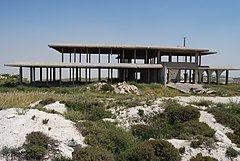Completed unfinished | Client King Hussein of Jordan Construction started 1965 | |
 | ||
The Royal Palace at Tell el-ful stands near Beit Hanina, atop a hill named Tell el-Ful (Hill of Beans, Hebrew: גבעת שאול, Givat Shaul, lit. Hill of Saul). It was intended to be a summer residence for King Hussein of Jordan, who had conquered Jerusalem and the rest of the West Bank and annexed the territory after the 1948 Arab-Israeli War. Construction started in the mid-1960s, but was interrupted when Israel captured the area during the 1967 War. Still owned by the Hashemite Kingdom, it remains today as found in 1967, an unfinished shell.
Contents
Location
The hill, located just west of Pisgat Ze'ev overlooking the Arab neighborhood of Shuafat, is 2,754 ft above sea level, making it one of the highest summits in the region. The identification of tell el-Ful with biblical Gibeah, the capital of King Saul, is generally accepted and ruins of a fortress are apparent at the site. Due to the sites archaeological significance, a number of digs have occurred at the site, the first in 1868. Jordanian plans to build the royal palace atop the mound prompted a third excavation in 1964 which attempted to salvage and document and findings prior to construction work.
Current usage
The palace was built in reaction to the locating of the residence of Israel's president in West Jerusalem. Intended to be the official holiday retreat of the Jordanian royal family, it was to be an architectural masterpiece that would host dignitaries from around the world. The design envisaged a grandiose structure consisting of three levels, interconnected with arches plated with Jerusalem stone. Construction came to a halt after the 1967 war when Israel took control of the West Bank. The structure was still a building site and was left uncompleted. The skeletal, two-storey cement structure remained empty and has since become a haven for drug users. Local officials said that attempting to redevelop the building and end the neglect would potentially "raise a storm in Jordan." In August 2011, the Jerusalem municipality stopped unauthorised workers who had erected a fence around the site. The Jerusalem wakf denied that Jordan was preparing to renovate the palace.
